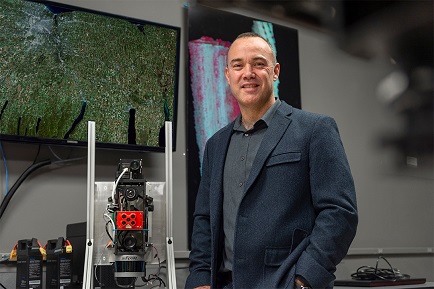Imaging scientists at the Rochester Institute of Technology (RIT) this month received nearly $400,000 in grants to support three projects aimed at improving the way scientists can use waveform lidar to study forests. Jan van Aardt, from RIT’s Chester F. Carlson Center for Imaging Science, received a $194,000 award from the National Geospatial-Intelligence Agency (NGA) and a $197,000 award from NASA for two interrelated remote sensing projects.
RIT will partner with Batelle Memorial Institute researchers on the NGA grant to create cleaner 3D subcanopy maps of forests. Lidar, despite exhibiting a strong signal where it hits the top of the forest canopy, tends to muddy when it interacts with different layers, such as those made of leaves and branches, van Aardt said.
“Waveform lidar is a special case of lidar. It is more difficult to interrogate, but in theory, if you have strong enough laser energy and good penetration through the canopy, it should interact with all the objects before a laser pulse hits the ground,” he said.
A full waveform lidar system, according to the National Ecological Observatory Network (NEON, operated by Battelle and funded by the National Science Foundation), records a distribution of returned light energy, often capturing more information than discrete return lidar systems as a result. A discrete return lidar system records individual (discrete) points for the peaks in the waveform curve, recording a point, or return, at each peak location in the waveform curve.

Jan van Aardt from the Chester F. Carlson Center for Imaging Science received a $194,000 award from the National Geospatial-Intelligence Agency and a $197,000 award from NASA for two new projects to improve the way waveform lidar can be used to study forests. Courtesy of Elizabeth Lamark, RIT.
Once a drone or aircraft completes a lidar scan, the scene beneath the imaged canopy is broken into tiny voxels, or “volumetric pixels” — the 3D equivalent of pixels. Voxels are filled when a signal is detected and left empty when a signal is not picked up. The new approach will flag voxels when a determination cannot be made either way.
“We use the term ‘ghost voxels’ to describe those voxels that we don’t know anything about and we don’t know why they’re not returning data,” said Robert Wible, an imaging science Ph.D. student working on the project. “We think there could be some structure or material there, but we’re not entirely confident.”
Identifying that uncertainty could be beneficial for the military intelligence community when trying to identify potential threats hidden in a forest, Wible said. The project could also benefit the ecological community, potentially leading to more information about subcanopy tree structure, wildlife habitats, species migration patterns, and more.
Battelle will lead the NASA projects in collaboration with RIT and the University of New Hampshire. That work will pair waveform lidar with hyperspectral sensing to enable scientists to better monitor forest growth and productivity. The researchers believe waveform lidar and hyperspectral sensing can provide data about important leaf traits such as nutrition, density, angularity, and area density that provide indicators about a forest’s overall health.
The team will create detailed 3D simulations of forests and evaluate their new techniques using the RIT-developed DIRSIG (digital imaging and remote sensing image generation) model. DIRSIG will allow the researchers to test different approaches in a controlled, physics-based environment, before extending algorithms to real-world imagery and 3D lidar.
“We are trying to better measure the 3D distributions of leaves, which is a hard thing to do and is time-consuming when using field-based techniques,” said Keith Krause, a remote sensing scientist with Battelle.
“In a simulated environment, you can figure out exactly how many leaves there are. We can grow CAD trees of all shapes and sizes and do a study to test what happens to the lidar signal if we change one little parameter.”